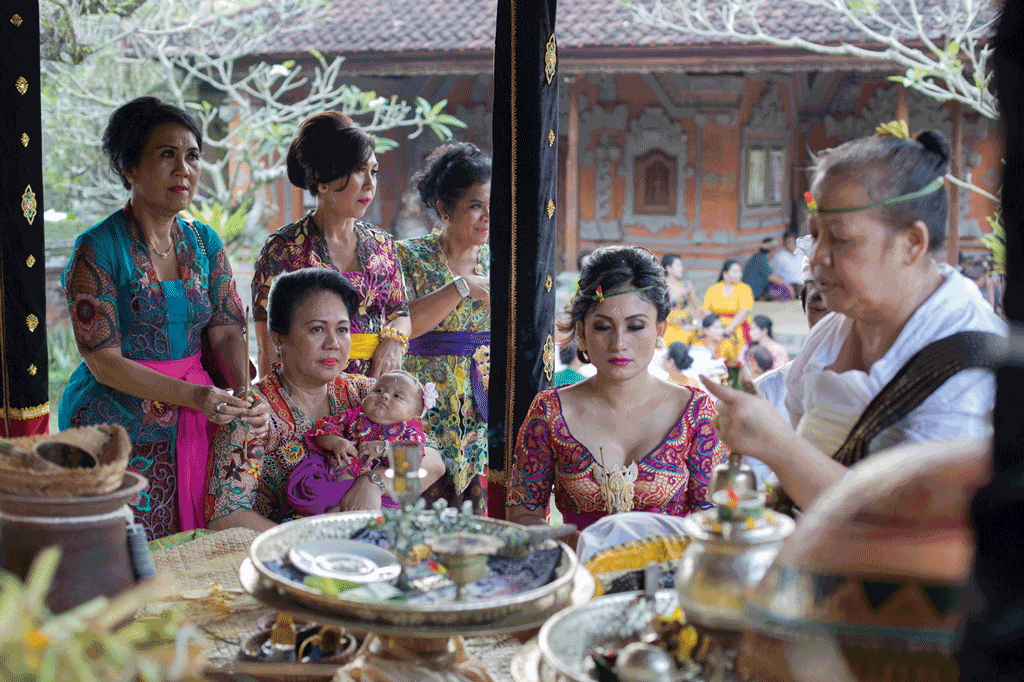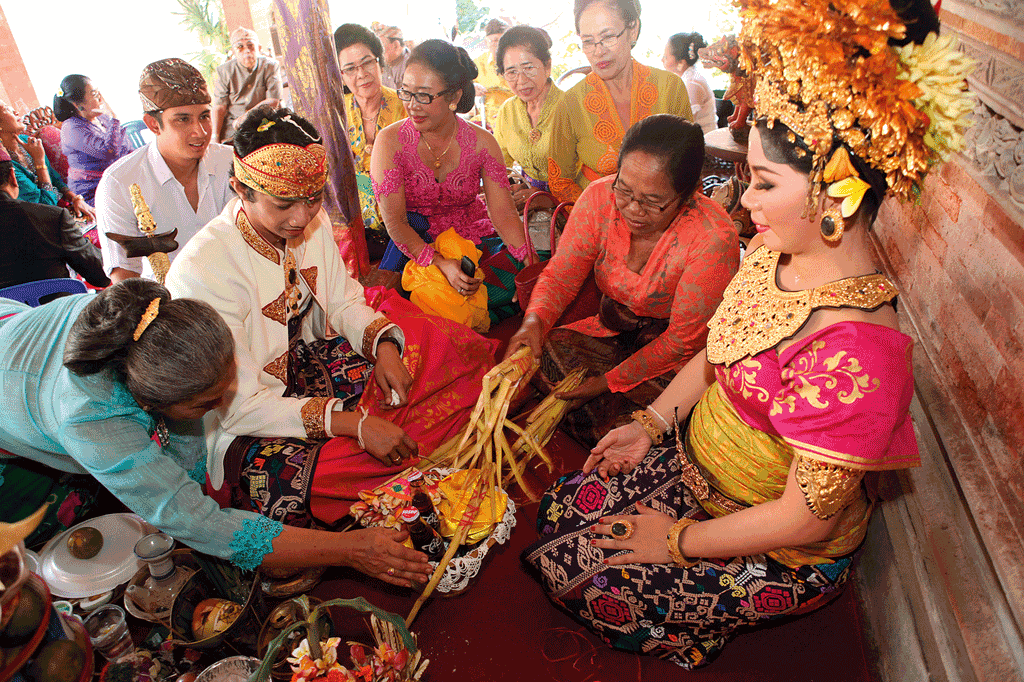Since the puputans (fight to the end) of 1906 and 1908, which destroyed the political system of Bali and integrated the island into the Dutch-run archipelago, the Balinese quadripartite caste system (Brahmana, Satria, Wesia and Sudra) has undergone many changes, some inherent to the economic transformation of Balinese society itself, other origination in the exposure of Bali to other ideologies.

Traditional Bali was an agrarian, rice-growing society focused around a set of princely puris (palaces) organising the socio-political life and regulating the distribution of land and water and, intertwined into it, a set of grias (brahmins’ mansions) giving to the same system its seal of sacredness. The princes and Satrias were the masters of the politico-economic system, while the Brahmanas kept control over its symbolic foundation. These two castes and a third group of dependant enforcers, the Wesias , made up the local aristocracy, globally known as Triwangsas or Menaks. But the majority -90%- of the population consisted of a fourth group, the mainly peasant Sudras, also called Jabas (outsiders) or Panjaks (commoners). This caste system, called Caturwangsas (four castes), to which was associated a system of hierarchy kinship groups (warga) perpetuated itself as an efficient tool for the running of the agrarian basis of society.

All this has changed. The primacy of agriculture is a thing of the past. The accelerated economic growth of the last fifty years has destroyed what remainders of the ancient social system, already shattered by colonisation. The princes have now not only lost political power, but their descendants have moved to the city, leaving most of their palaces empty back home, in the hinterland villages. This has to a certain extent benefited their partners of old, the Brahmanas, because of the latter’s resilient control over religious symbols – especially through the preparation of the most potent holy waters (tirta). With the help of modern education though, individuals from “lower” groups are moving up and now putting up challenges at all levels of the social system, including dwijati (twice-born) priesthood. Generalised social mobility is thus slowly, but surely, pushing aside the old system of ascribed caste status. Bereft of their original agrarian function, the castes (Caturwangsas) and kinship groups (wargas) are now no more, than tools in the generalised scramble for economic power, alongside wealth and knowledge, on which rests the modern claims to status and prestige. A class system is thus slowly superseding the caste system.
Dutch-imported modernity has definitely played a role in this transformation. It has brought along the ideas of progress (kemajuan) and equality of rights, inherited from the European Enlightenment. Yet, other factors should also be acknowledged. One is the growing presence of Islam and Christianity, whose followers constitute powerful minorities. Those religions value a social stratification based on wealth or moral virtue, definitely not on ascribed caste-status. They carry an egalitarian appeal that strikes as contradictory to the Hindu or Hindu-Balinese caste system. But arguably more important indeed is, after seven centuries, the reopening of contacts between Bali and India, which enable the Balinese to borrow from the Indian 19th century reformed movement of Hinduism, which propose a return to the Vedas.
So it is no surprise if some progressive Balinese claim that the caturwangsa four-caste system of the Balinese results from an historical misinterpretation of the Veda-based Hindu theory of social stratification. To them, referring to the Veda, “real” Hinduism classifies people in “four colours” or caturwarnas: the men/women of power or Satrias, the men/women of religion or Brahmanas, the men/women of commerce or Wesias, and finally the workers or Sudras. Nowhere do the texts state that these occupations are inherited. “Real” Hindu social status is achieved as the “fruit” of people past life’s (karma or deeds… The two systems, caturwarna of the Veda and caturwangsa of the Balinese, are therefore each other’s symmetric opposites. The first rests on achieved status, albeit with a religious flavour – it is the fruit of one’s “past”; and the second on ascribed status – children inherit their parents’ position. Thus inherited status, that of Satria princes and Brahmana priests such as found in Balinese society, is no less than an “historical misunderstanding”, which should be discarded.
Progressive Balinese use the Veda to question the legitimacy of the existing Balinese social structure. This is definitely a “fundamentalist” interpretation, but it ends up being progressive and a challenge to the traditional caste system. On the account of it, people of “low” inherited origin who occupy functions at the Department of Hindu Affairs can claim to be genuine brahmins, whereas the traditional village Brahmins are in their eyes historical “accidents”. Just imagine the tussle when they meet…
This is an important issue, that also reflects the insertion of Bali into wider Indonesian society. Putu Setia, a well-known Balinese journalist from Jakarta, explains how his Balinese identity is often challenged by fellow Indonesians with remarks such as these: “Don’t all leaders in Bali have to belong to the highest caste?” or: “with or without elections, Bali cannot be democratic,” or:”I want to become Hindu, as long as I’m high-caste Hindu.” And he wily ads, while wondering: “Do they only joke when they mix Hinduism and caste”? This reveals a nagging problem: while Bali is the country’s best cultural window and a source of national pride, most Indonesians, including intellectuals and businessmen, who often use the image of the island for their own purposes, ignore the deepest aspect of this culture: its religion.
Interestingly, to Putu Setia, such ignorance and misunderstanding is also the fault of the Balinese. He adds that in order to be national, and hence better accepted by fellow Indonesians, Hindu identity should rest on the universality of Bali’s religion, Veda Hinduism, rather than on the idiosyncrasies of its ethnic culture, Balinese Hinduism. Hence the necessity to get rid of the anachronism of the caste system – the caturwangsa version – which not only is an impediment to modernity, but also creates misconceptions amongst Moslems and Christians.
But Putu Setia and the modernists go on one step further. According to them, the best way to defend Bali is by uniting at a national level all the non-Balinese Hindu traditions – none of which has a caste system of its own – under a single, pan-Indonesian umbrella, that of the Parisada. Bali is only one of the many Hindu traditions of the country – Semarang, Boyolali, Klaten in Java, Kaharingan in Kalimantan are prime examples, to which could be added, Blitar and Tengger in Java, Tanah Toraja, Tanah Batak and other remote groups who make up, altogether, the other half of the roughy 6 million Hindus in the country. Only by uniting all the Hindus in the country under a single rationalised Hinduism can this religion fully occupy the social and political space, which is allocated to it by the Indonesian constitution and the Pancasila ideology.
Balinese high-caste religious leaders, Putu tells us, actually share in this view for the necessity of a national Hinduism and are therefore ready to cast aside the local Balinese caste system. To gain full recognition, Hinduism has to take off its Balinese guise and put on the “universal guise” of Hinduism such as described by the Scriptures (the Wedas).
The only problem is that this “return-to-the-source” Hinduism is a challenge to Balinese social habits. According to the caturwangsa system – it is difficult for a Sudra in a position of power to have his claim accepted that he is functionally a Satria. Or to have anyone believe that an official of the department of Hindu affairs is a functional Brahmana.
Based on the reading of “Kasta dalam Hindu: kesalahpahaman berabad-abad” , by Ketut Wiana, Raka Santeri with introduction of Putu Setia, Bali Post, 1993.









